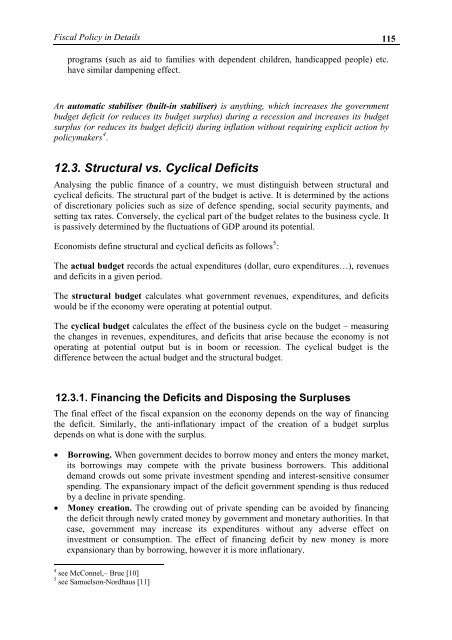MacroeconomicsI_working_version (1)
Create successful ePaper yourself
Turn your PDF publications into a flip-book with our unique Google optimized e-Paper software.
Fiscal Policy in Details 115<br />
programs (such as aid to families with dependent children, handicapped people) etc.<br />
have similar dampening effect.<br />
An automatic stabiliser (built-in stabiliser) is anything, which increases the government<br />
budget deficit (or reduces its budget surplus) during a recession and increases its budget<br />
surplus (or reduces its budget deficit) during inflation without requiring explicit action by<br />
policymakers 4 .<br />
12.3. Structural vs. Cyclical Deficits<br />
Analysing the public finance of a country, we must distinguish between structural and<br />
cyclical deficits. The structural part of the budget is active. It is determined by the actions<br />
of discretionary policies such as size of defence spending, social security payments, and<br />
setting tax rates. Conversely, the cyclical part of the budget relates to the business cycle. It<br />
is passively determined by the fluctuations of GDP around its potential.<br />
Economists define structural and cyclical deficits as follows 5 :<br />
The actual budget records the actual expenditures (dollar, euro expenditures…), revenues<br />
and deficits in a given period.<br />
The structural budget calculates what government revenues, expenditures, and deficits<br />
would be if the economy were operating at potential output.<br />
The cyclical budget calculates the effect of the business cycle on the budget – measuring<br />
the changes in revenues, expenditures, and deficits that arise because the economy is not<br />
operating at potential output but is in boom or recession. The cyclical budget is the<br />
difference between the actual budget and the structural budget.<br />
12.3.1. Financing the Deficits and Disposing the Surpluses<br />
The final effect of the fiscal expansion on the economy depends on the way of financing<br />
the deficit. Similarly, the anti-inflationary impact of the creation of a budget surplus<br />
depends on what is done with the surplus.<br />
• Borrowing. When government decides to borrow money and enters the money market,<br />
its borrowings may compete with the private business borrowers. This additional<br />
demand crowds out some private investment spending and interest-sensitive consumer<br />
spending. The expansionary impact of the deficit government spending is thus reduced<br />
by a decline in private spending.<br />
• Money creation. The crowding out of private spending can be avoided by financing<br />
the deficit through newly crated money by government and monetary authorities. In that<br />
case, government may increase its expenditures without any adverse effect on<br />
investment or consumption. The effect of financing deficit by new money is more<br />
expansionary than by borrowing, however it is more inflationary.<br />
4 see McConnel,– Brue [10]<br />
5 see Samuelson-Nordhaus [11]




